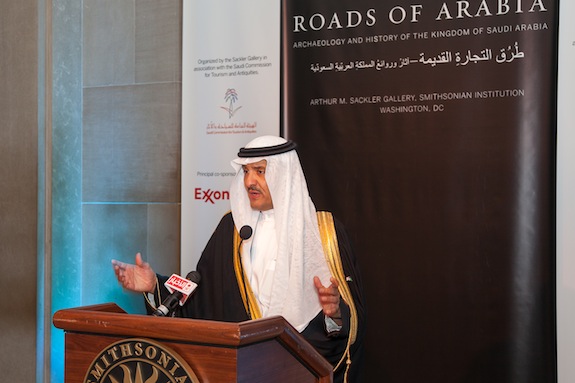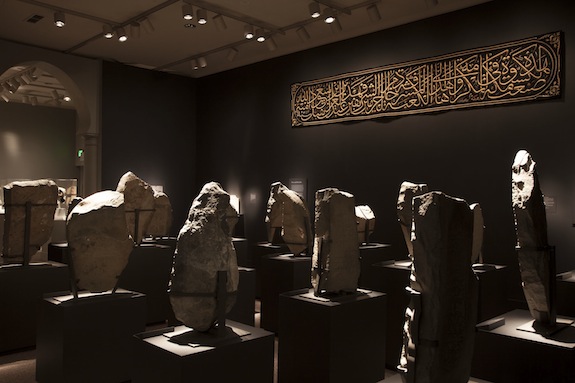Q+A: Saudi Arabia’s Sultan bin Salman on “Roads of Arabia”
Saudi Arabia’s royal tourism minister discusses a groundbreaking new exhibition, the U.S.-Saudi Arabian relationship, and what it’s like to look at Earth from space
![]()

The Prince Sultan speaks at the opening of the “Roads of Arabia” exhibition. Image courtesy of the Sackler Gallery
Sultan bin Salman, the son of Saudi Arabia’s crown prince, serves as the Secretary-General of the country’s Supreme Commission for Tourism and Antiquities. A former fighter pilot, he became the first-ever Arab in space while serving on the fifth flight of NASA’s Discovery program as a payload specialist in 1985. He recently traveled to Washington, D.C. for the North American premiere of the “Roads of Arabia” exhibition, now on view at the Sackler Gallery—a groundbreaking collection of newly discovered artifacts from the Arabian Peninsula—and sat down with Around the Mall to discuss the show, the U.S.-Saudi Arabian relationship and what it’s like to look at Earth from space.
What’s so special about this exhibition, and why did you decide to travel here for the opening of it?
It is really a window to Saudi Arabia not seen before. It’s a new focus on the heritage of Saudi Arabia, and its history, that connects very much to its future.
People have to see Saudi Arabia as not being just a barren desert. Although people of the desert, like myself, take offense when people say it’s a “barren desert.” The desert is very rich: One night in the desert will really show you a different version of the universe that you’ve never seen before. And Saudi Arabia is not all desert to begin with—we have mountains, beautiful countryside, rivers and very vibrant communities.
But this window is opening to something new, to the history of Saudi Arabia, to the cultures and civilizations that have crisscrossed it. Hence the name, “Roads of Arabia.” This very critical and important part of the world, in the sense of its geographic location. The great religions of the world were all created in that part of the world. And Saudi Arabia has been the center of incredible civilizations, going back thousands of years. It’s very important for the world to see another dimension of Saudi Arabia. This is a nation that didn’t come from nowhere. And also, Islam, as a great religion, came to Mecca, a site and a place where culture and politics and trade well and alive. So Islam came to a place in the world that is very complex, very rich, and not void.
So it is really timely. If you’re going to see Saudi Arabia well, you need to see it from where it came, in terms of history. This is represented by the artifacts and beautiful objects that tell the story.
What can museumgoers learn about Saudi Arabia that might surprise them?
Every culture that has come through Saudi Arabia, every civilization that has crisscrossed the “Roads of Arabia,” has left its imprint. Some of these civilizations have left an imprint in terms of objects. Many of them have left archaeological sites, like Mada’in Saleh, which was the first UNESCO World Heritage Site in Saudi Arabia. It is the Southern capital of the Nabateans, or the original Arabs, who wrote the original Arabic language.
These civilizations also left a lot of stories, whether stories written in rock art or other artifacts—the beautiful statues, jewelry and pottery in the exhibit. The diversity of things that we’re discovering today in Saudi Arabia is staggering, and we’re not even scratching the surface, according to the experts of antiquities.
When Americans think about cultural tourism, they might think of Petra in Jordan or Machu Picchu. Do you imagine Saudi Arabia as someday being a destination for cultural tourism?
I have to assure you one hundred percent that this exhibition is not really meant to encourage people to go to Saudi Arabia. We are not even open for tourism, the way you see it. We are really in the build-up stage of our national tourism. Sites are not necessarily prepared the way we want them to be prepared, including Mada’in Saleh.
So this is mainly a window on a country that is very much intertwined with America, in particular. We have been friends for tens of years, and we’ve gone through thick and thin together. But Saudi Arabia has always been seen by most of the American public simply as the world’s largest producer of oil. When oil prices go up, we take the brunt of criticism, to say it politely, while we probably are not to blame.
We are keen that, in the U.S., people see Saudi Arabia from a different light. It’s almost like if you came to a major art exhibition, or you came back to a major architectural exhibition of Saudi architects, but on a much deeper scale. You’d see a human dimension. In this exhibition, you’re seeing multiple human dimensions throughout thousands of years of history.
When this exhibition was shown in Europe, what did people think?
It was stunning—between a million and a half and two million people visited the exhibition. Those are not people going for joyrides, they’re people that went on a learning experience. We think that, in America also, this will be a learning experience. We invest a lot in America, and I don’t mean financially—we are investing in bringing closer, rather than standing between people. I think these are two countries that need to work together towards the future. It’s very important. It’s a must that people understand each other better. Your President Obama has always spoken of Saudi Arabia as a great nation, and a great friend of the U.S., so as did the other predecessors. And we in Saudi Arabia think of America as a great nation that is leading the world towards the future. We all, as humans of one earth—having also seen earth from the perspective of space—eventually we’re going to have to find those common grounds. One of those common grounds is understanding where we came from.

The Prince Sultan aboard NASA’s Discovery Shuttle (right) with Patrick Baudy. Image via NASA
It’s funny you mention space—for our readers, who are really interested in science and space as well as art, I wanted to ask you what it was like to actually go into orbit.
It’s an incredible revelation. I still carry the memory of seeing Earth smaller, a lot smaller, than I thought it was. I still carry the memory of seeing Earth in the vastness and blackness of space. That hit me hard. Thinking, we all have different languages and different cultural backgrounds and different religions, but we all actually live on that one space ship, one planet. Our fate is very much connected, intertwined.
This is, to me, the transition that has not been made, as much as we have become more sophisticated, talking to each other through social media and mobile phones. I still don’t know why we haven’t transitioned as humans. As many pictures as we’ve seen of earth from space, we still haven’t transitioned to understanding that this is a pretty small place, and we are not much different. We speak different languages but it is the same language, it’s a human language.
/https://tf-cmsv2-smithsonianmag-media.s3.amazonaws.com/accounts/headshot/joseph-stromberg-240.jpg)

/https://tf-cmsv2-smithsonianmag-media.s3.amazonaws.com/accounts/headshot/joseph-stromberg-240.jpg)